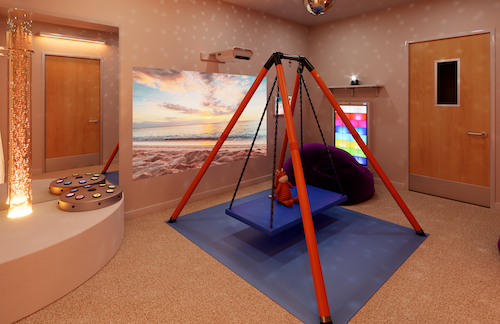Key points:
- The integration of sensory spaces into education is a necessary evolution
- See article: Schools are key to solving mental health equity gaps
- See article: How to build relationships with students
- For more news on SEL trends, visit eSN’s SEL and Well-Being page
As we stand on the cusp of a new year, it’s remarkable to reflect on how sensory spaces for schools have evolved. It has been quite heartening. This shift is not merely a coincidence; rather, it is a result of the collective recognition of the crucial role sensory well-being plays in the overall development and learning experience of our students. And in 2024, I predict that more districts will fully embrace the value and develop sensory spaces in their own schools.
Sensory spaces, initially developed as havens for individuals with severe sensory processing challenges, have found their place in mainstream education. The journey of sensory spaces from specialized rooms to widespread adoption within schools is a testament to the seismic changes occurring in our understanding of education, mental health, and well-being.
One catalyst for this shift has been the increased focus on social-emotional learning (SEL) in the wake of the global pandemic. The pandemic exposed the emotional vulnerabilities of our students, emphasizing the need for a holistic approach to education that extends beyond traditional academics. Sensory spaces have emerged as a tangible solution to address the emotional and sensory needs of students, contributing to a more inclusive and supportive learning environment.
Sensory spaces everywhere
Schools across the nation are integrating sensory spaces into their infrastructure, and this trend shows no signs of slowing down. Whether they’re using dedicated rooms or integrating corners within existing classrooms, educators are recognizing the transformative power of sensory spaces. These spaces are carefully designed to provide students with a variety of sensory stimuli, catering to individual preferences and needs.
Sensory spaces are not one-size-fits-all; they can be tailored to meet the unique requirements of different students. For some, a dedicated room filled with calming lights, soft textures, and interactive elements may be the ideal retreat. Others may find solace in a designated calming corner within their regular classroom, offering a discrete yet effective escape when needed. The flexibility of incorporating sensory spaces ensures that they can be adapted to suit the specific needs and available resources of each educational institution.
Why this matters in 2024 and beyond
The benefits of incorporating sensory spaces into educational settings are well-documented and far-reaching. Improved focus, reduced stress levels, and enhanced emotional regulation are just a few of the positive outcomes. Classrooms that embrace diverse learning styles and sensory needs foster an environment where every student can thrive.
As we move into 2024, the integration of sensory spaces into educational settings is not just a trend but a necessary evolution. It’s time for schools and districts to recognize the potential these spaces hold in shaping a more empathetic, inclusive, and effective learning environment. The benefits extend beyond the students to encompass teachers, administrators, and the entire school community.
For those educators and districts contemplating the introduction of sensory spaces, the process need not be overwhelming. Start by assessing the specific needs of your students and available resources. Engage with professionals experienced in sensory integration to design spaces that align with your goals and constraints. Seek input from students themselves, recognizing the valuable perspective they bring to the conversation.
The era of sensory spaces in education has arrived, and it’s a change worth celebrating. As we look toward the future, let us embrace the power of sensory spaces to create a learning environment that nurtures the well-being and success of every student. By 2024, I believe we will witness the widespread adoption of sensory spaces in schools, marking a monumental step towards a more compassionate and effective educational landscape.
- 4 ways to encourage play in education - April 25, 2024
- CoSN IT Leader Spotlight: Lisa Higgins - April 25, 2024
- It’s time to pay student teachers - April 25, 2024

